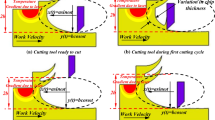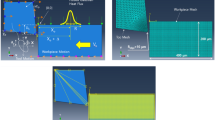Abstract
Vibration-assisted cutting is considered a feasible way to cope with difficult-to-machine materials. Within the present paper, ultrasonic elliptical vibration-assisted milling (UEVM) is adopted to the machining of Ti-6Al-4V titanium alloy. Velocity coefficient K is introduced to describe the separating characteristic of the UEVM. Theoretical analysis of separating type and non-separating type cutting using the UEVM method is performed. Subsequently, experimental investigations of cutting force, chip formation, and surface morphology are conducted by comparing the UEVM with the conventional milling (CM). Results show that compared with non-separating type UEVM, separating type UEVM can bring more reduction of average radial cutting force and the chips are visibly thinner under the UEVM condition with K < 1 than those produced under CM condition using the same cutting parameters. However, the surface roughness in the UEVM is significantly larger than those in the CM due to the periodic motion component of the teeth of milling tool in the direction perpendicular to machining surface with the application of ultrasonic elliptical vibrations.









Similar content being viewed by others
References
Zhu Z, Guo K, Sun J, Li J, Liu Y, Chen L, Zheng Y (2018) Evolution of 3D chip morphology and phase transformation in dry drilling Ti6Al4V alloys. J Mater Process Technol 34:531–539
Li A, Zhao J, Luo H, Pei Z, Wang Z (2012) Progressive tool failure in high-speed dry milling of Ti-6Al-4V alloy with coated carbide tools. Int J Adv Manuf Technol 58(5-8):465–478
Liu J, Jiang X, Han X, Gao Z, Zhang D (2018) Effects of rotary ultrasonic elliptical machining for side milling on the surface integrity of Ti-6Al-4V. Int J Adv Manuf Technol 101(5-8):1451–1465
Bai W, Bisht A, Roy A, Suwas S, Sun R, Silberschmidt V (2018) Improvements of machinability of aerospace-grade Inconel alloys with ultrasonically assisted hybrid machining. Int J Adv Manuf Technol 101(5-8):1143–1156
James S, Sonate A (2017) Experimental study on micromachining of CFRP/Ti stacks using micro ultrasonic machining process. Int J Adv Manuf Technol 95(1-4):1539–1547
Zhang X, Kumar A, Rahman M, Nath C, Liu K (2011) Experimental study on ultrasonic elliptical vibration cutting of hardened steel using PCD tools. J Mater Process Technol 211(11):1701–1709
Liu J, Zhang D, Qin L, Yan L (2012) Feasibility study of the rotary ultrasonic elliptical machining of carbon fiber reinforced plastics (CFRP). Int J Mach Tools Manuf 53(1):141–150
Jamshidi H, Nategh M (2013) Theoretical and experimental investigation of the frictional behavior of the tool–chip interface in ultrasonic-vibration assisted turning. Int J Mach Tools Manuf 65:1–7
Ni C, Zhu L, Liu C, Yang Z (2018) Analytical modeling of tool-workpiece contact rate and experimental study in ultrasonic vibration-assisted milling of Ti–6Al–4 V. Int J Mech Sci 142:97–111
Razfar M, Sarvi P, Zarchi M (2011) Experimental investigation of the surface roughness in ultrasonic-assisted milling. Proc Inst Mech Eng B J Eng Manuf 225(9):1615–1620
Maurotto A, Wickramarachchi C (2016) Experimental investigations on effects of frequency in ultrasonically-assisted end-milling of AISI 316 L: a feasibility study. Ultrasonics 65:113–120
Ko J, Tan S (2013) Chatter marks reduction in meso-scale milling through ultrasonic vibration assistance parallel to tooling’s axis. Int J Precis Eng Manuf 14(1):17–22
Li K, Wang S (2014) Effect of tool wear in ultrasonic vibration-assisted micro-milling. Proc Inst Mech Eng B J Eng Manuf 228(6):847–855
Zheng K, Liao W, Dong Q, Sun L (2018) Friction and wear on titanium alloy surface machined by ultrasonic vibration-assisted milling. J Braz Soc Mech Sci Eng 40(9):411
Ko J, Shaw K, Chua H, Lin R (2011) Cusp error reduction under high speed micro/meso-scale milling with ultrasonic vibration assistance. Int J Precis Eng Manuf 12(1):15–20
Jin X, Xie B (2015) Experimental study on surface generation in vibration-assisted micro-milling of glass. Int J Adv Manuf Technol 81(1-4):507–512
Abootorabi Z, Razfar M, Abdullah A (2012) Investigation of the effect of cutting speed and vibration amplitude on cutting forces in ultrasonic-assisted milling. Proc Inst Mech Eng B J Eng Manuf 226(7):1185–1191
Shen X, Zhang J, Li H, Wang J, Wang X (2012) Ultrasonic vibration-assisted milling of aluminum alloy. Int J Adv Manuf Technol 63(1-4):41–49
Shen X-H, Zhang J, Xing DX, Zhao Y (2012) A study of surface roughness variation in ultrasonic vibration-assisted milling. Int J Adv Manuf Technol 58(5–8):553–561
Tao G, Ma C, Shen X, Zhang J (2016) Experimental and modeling study on cutting forces of feed direction ultrasonic vibration assisted milling. Int J Adv Manuf Technol 90(1-4):709–715
Moriwaki T, Shamoto E (1995) Ultrasonic elliptical vibration cutting. CIRP Ann Manuf Technol 44(1):31–34
Ma C, Shamoto E, Moriwaki T, Wang L (2004) Study of machining accuracy in ultrasonic elliptical vibration cutting. Int J Mach Tools Manuf 44(12–13):1305–1310
Jiang X, Liang H, Lu H, Dai J, Zhang D (2014) Investigation of ultrasonic elliptical vibration milling of thin-walled titanium alloy parts. Acta Armamentarii 35(11):1891–1897
Chern G-L, Chang Y-C (2006) Using two-dimensional vibration cutting for micro-milling. Int J Mach Tools Manuf 46(6):659–666
Ma C, Ma J, Shamoto E, Moriwaki T (2011) Analysis of regenerative chatter suppression with adding the ultrasonic elliptical vibration on the cutting tool. Precis Eng 35(2):329–338
Ding H, Ibrahim R, Cheng K, Chen SJ (2010) Experimental study on machinability improvement of hardened tool steel using two dimensional vibration-assisted micro-end-milling. Int J Mach Tool Manu 50(12):1115–1118
Sui H, Zhang X, Zhang D, Jiang X, Wu R (2017) Feasibility study of high-speed ultrasonic vibration cutting titanium alloy. J Mater Process Technol 247:111–120
Liu J, Jiang X, Han X, Zhang D (2019) Influence of parameter matching on performance of high-speed rotary ultrasonic elliptical vibration-assisted machining for side milling of titanium alloys. Int J Adv Manuf Technol 101(5):1333–1348
Author information
Authors and Affiliations
Corresponding author
Additional information
Publisher’s note
Springer Nature remains neutral with regard to jurisdictional claims in published maps and institutional affiliations.
Rights and permissions
About this article
Cite this article
Han, X., Zhang, D. Effects of separating characteristics in ultrasonic elliptical vibration-assisted milling on cutting force, chip, and surface morphologies. Int J Adv Manuf Technol 108, 3075–3084 (2020). https://doi.org/10.1007/s00170-020-05463-y
Received:
Accepted:
Published:
Issue Date:
DOI: https://doi.org/10.1007/s00170-020-05463-y




